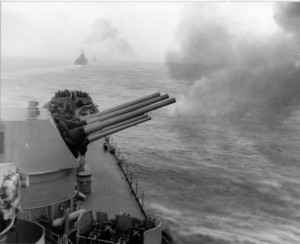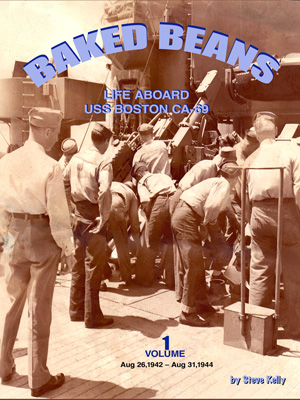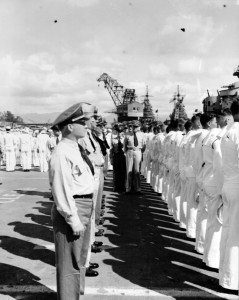 It’s easy to overlook the basics when writing a blog, and I thought I’d take a few posts in the coming months and try to outline what the BOSTON’s role was in the war. Many of us are here because we knew a sailor; but that doesn’t give us context for what the heck 1,700 sailors and officers were doing floating around the Pacific.
It’s easy to overlook the basics when writing a blog, and I thought I’d take a few posts in the coming months and try to outline what the BOSTON’s role was in the war. Many of us are here because we knew a sailor; but that doesn’t give us context for what the heck 1,700 sailors and officers were doing floating around the Pacific.
The fleet of the US Navy in World War II had many types of ships, the Battleship, The Aircraft Carrier, the Cruiser, the Destroyer, and supply/support ships made up the fleet in the pacific. The USS BOSTON was a heavy cruiser, which meant it was smaller than a battleship, and bigger than a destroyer. Cruisers had been around for a few hundred years, they were cheaper to produce than battleships, and they commanded attention because of their large guns which were used to bombard shoreline targets of attack other enemy ships. By World War II, these guns on cruisers were so large they could shoot at targets over the horizon!
During World War I and before, the key role in the Navy, the status ship was the battleship. It was huge, and it was the dominant Naval vessel to date. In the transition years between the wars and with the outbreak of World War II, navies around the world armed with two new weapons, the submarine, and the aircraft carrier. This changed the nature of the conflict, since a $10,000 plane flying from a aircraft carrier, could take out a hundreds of million dollar battleship. Submarines could also send a $1,000 torpedo to eliminate the same battleship. At the start of World War II, what we didn’t know is the age of the battleship was over, and the dawn of the aircraft carrier was upon us.
The Boston was directly affected by this change. It served two strategic purposes in World War II: Strategic bombardment of Islands held by the Japanese (usually bombarding airfields), and protecting Aircraft Carriers with anti-aircraft fire. The Navy in World War II in the Pacific, created ‘Task Forces’ where many ships were organized into a fleet. The Boston participated in Task force 58 and Task force 38, the so called ‘fast carrier’ tasks forces of the war. These fleets were also known as the third fleet and the fifth fleet; actually they were the same fleet, When Admiral Spuance was leading the group was 38, and when Admiral Halsey was leading it was renumbered to 58. This was done to deceive the Japanese into thinking there were two fleets.
You should think about this fleet as a set of concentric circles, with Aircraft Carriers in the center of the circle, Battleship and Cruisers using the anti-aircraft capabilities to protect the carriers (and themselves), and the destroyers patrolling the outer circle looking for submarines. To complicate things, it was not safe for any of the large ships to travel in a straight line when threatened by submarines, so they zig zagged while heading toward a specific goal. Never a straight line.
One other reality, was the USS BOSTON under a full head of steam, would consume 40,000 gallons of navy oil a day, and with 1,700 men that’s a lot of spam to feed them. So supply and logistics dominate the discussion.
So the key role of the BOSTON flipped sometimes every day between bombardment of places like IWO JIMA, and shooting down enemy planes that approached the carriers.



